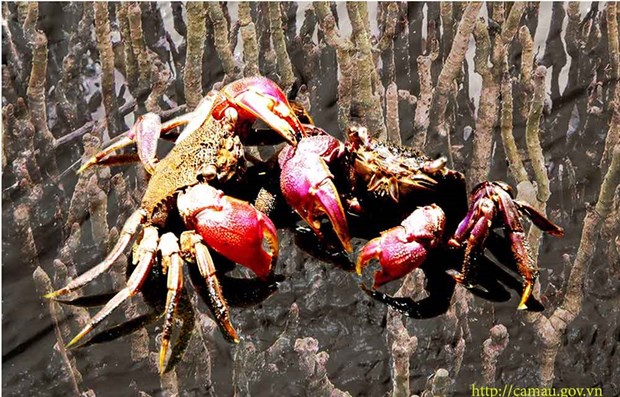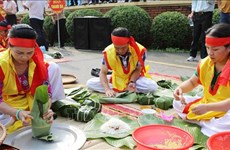Ca Mau receives national recognitions for cultural heritage
 Ba khia crabs live in mangrove forests (Nguồn: camau.gov)
Ba khia crabs live in mangrove forests (Nguồn: camau.gov)Hanoi (VNA) - The information was released by Tran Hieu Hung, Director of Ca Mau provincial Department of Culture, Sports and Tourism on December 24. He said the recognition by the Ministry of Culture, Sports and Tourism offers the province a great opportunity for preserving and promoting its cultural values and developing tourism.
In U Minh District in the southernmost province of Ca Mau, there is a popular job called “gac keo ong” which literally means ’the guard of honey bees hives’.
The guards make “keo ong” to lure bees to come and build their hives; they will then wait to harvest the honey.
The “keo” is usually made of a dry cajuput branch which is as wide as an adult’s calf, and is about two or three metres long.
Before being taken into the forest, the “keo ong” is covered with beeswax to lure bees. Two holes are made at the ends of the branch so that it can easily be held up in the trees.
The honey guards consider factors including wind direction, sunlight, and honey bees’ flight paths to select the best place to put the keo ong. On top of this, the branch should hang at an incline of 60 degrees to ensure sunlight can reach it.
Experienced guards can predict exactly when the bees will arrive at the keo ong to build hives; they also know how long it will take for the bees to produce enough honey to be harvested.
Before collecting honey, the honey guards burn tinder wood next to the hives, which causes the bees to flee, he said. When collecting the honey, it is important to leave some honey cones, so that bees can return to the hive to produce more.
In1984 local bee hive guards established a group to share information and experience on their work. The group is now a cooperative with many members, monitoring more than 7,200 keo ong in a cajuput forest area of 520 ha.
As the cajuput forest is part of Ca Mau Cape Reserve Area, members of the cooperative are offered technical training and protective equipment to collect honey and avoid causing forest fires.
During the rainy season, honey collectors can apply traditional methods to collect honey, but during the dry season they have to wear protective clothes, and use special equipment to avoid causing fires when smoking out the hives.
Ba Khia (mangrove crabs) are crabs that live among mangroves.
The best moment to hunt for ba khia is during low tide when the crabs come out of their holes to hunt for food.
The meat of ba khia is firm, sweet and aromatic because they eat the fruits of the mangrove forest.
Ba khia could be cooked into many delicious dishes, especially fermented ba khia paste, a well-known dish of southern Vietnam that every tourist should try. The best paste is said tobe found in Nam Can, Dam Doi and Phu Tan districts.
Making fermented bakhia paste has been passed down though generations of locals in Ca Mau province. Thanks to applying the traditional handmade process, fermented ba khia paste in Ca Mau has unique taste compared to that from different provinces.
Following the recognition of the aforementioned national intangible cultural heritages, the province will also submit requests for a fish worshipping ceremony in the Doc River in 2020, a worship ceremony at Hung King Temple in 2021, and handmade dry shrimp in 2022.
Submissions for worship ceremonies of Lady Thuy Long, who protects people living in river deltas, and Lady Thien Hau, who protects fishermen at sea, will be sent in 2023 and 2024, respectively.
Ca Mau will launch a separate preservation plan for each nationally recognised heritage every year.
The province will open a room in the province’s museum to display a temporary exhibition featuring the intangible cultural heritage of the area.
From 2025 to 2030, the province will continue to seek intangible cultural heritage for preservation./.













